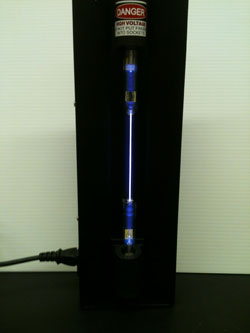![]()
Atomic Structure, Periodic Trends
8.1 Spectral Emission Tubes
Subjects: Atomic structure, electromagnetic radiation

 (250x141).jpg)
Description: Display of atomic emission lamps containing different gases. Excitation of electrons in the gases result in emission of different wavelengths of light.
Materials:
- Emission tube power supply with various emission tubes (H2, O2, Ne, Ar, Kr, Xe, CO2)**
- Display board with several atomic emission tubes (H2, Ar, Ne, He, Hg?)*
- Tesla coil*
- Spectroscopes or gratings (in the cabinet with other materials)
- Optional: Vernier Spectro-Vis spectrometer with emission insert (no interface needed, plugs directly into laptop. Logger Pro software required)*
**Too large for bin. Located in cabinet.
*Shared item. Located in the drawer opposite the chemical storage cabinets. The spectrometer is located in the drawers opposite the bin storage shelves.
Procedure:
- Insert desired emission tube.
- Plug in the power supply.
- Dim the lights in the room
- Turn on the power supply.
- For the board with mounted tubes: Using the Tesla coil, activate each emission tube individually to show the emission spectra of certain gaseous elements or compounds.
Discussion:
When the lamps are charged with the Tesla coil or electric power supply, energy is transferred to the gases in the tube. This energy causes the electrons to be excited into higher energy states. As the electrons relax back to a lower energy state, a photon of light is emitted. The energy or wavelength of the photon is equal to the energy difference between the lower energy state and the excited state. Each element or compound has its own discreet energy levels and thus will emit their own characteristic wavelengths (colors) of light.
Safety:
Do not plug in the power supply until you have already inserted the emission tube. Since this equipment requires high voltage, care should be exercised to avoid shocks. After using the Tesla coil, turn down the power and unplug. If left on, the Tesla coil can become hot and the risk of burns exists.
Disposal:
None.
References:
1. NCSU Department of Chemistry Lecture demonstration website: http://www.ncsu.edu/project/chemistrydemos/DemoList.html


